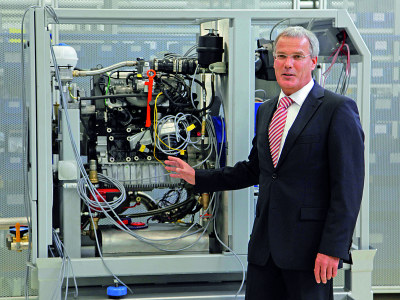Dec
2
Own Your Own Power Plant
December 2, 2010 | 4 Comments
It’s likely coming and already for sale in Germany as of last week. German gas supplier LichtBlick has installed its first home power plants for residential and commercial customers in Hamburg, Germany. The plants are Volkswagen built EcoBlue natural gas powered compact combined heat and power (CHP) plants produced by VW exclusively for LichtBlick. The EcoBlue power source is an internal combustion piston engine.
VW is claiming energy consumption is reduced by up to 40% compared with a conventional heat and power supply. If so, and actually it doesn’t have to be that good, the product offers those in rural areas a solid perfuming, well known technology to go off grid.
But in Germany the plan isn’t about go off grid, its decentralized power plants. The plan is “sell” (build) the same capacity as two atomic power plants. LichtBlick plans eventually to network some 100,000 of the distributed home power plants to form a 2,000 MW virtual decentralized power plant to handle fluctuations in future electricity generation as renewables grow to represent a larger component of the power mix, according to Dr. Christian Friege, CEO of LicbtBlick. That promises to be a major logistics task and communications effort as well.
The VW EcoBlue units consist of a natural gas engine that powers a generator with the exhaust gas used for the heating component. The deal for consumers is the plan, called “ZuhauseKraftwerke” (home power plants), are “sold” starting in 2010 with the customer paying an installation “contribution” of €5,000. Which makes one wonder, after the initial “contribution” what else comes? That’s more than $6,500US as this is written.
Surely there is some cash or billing credit working the consumer’s way. The basic idea is the ZuhauseKraftwerk will only generate power on demand, the heat produced at the same time will be stored, allowing reliable supplies of heating energy and warm water to the building at all times. Just who is deciding when the demand calls for operations? Just how the demands for electricity and heat are reconciled isn’t discussed, in English anyway.
Agreements have already been reached with SAGA GWG, a Hamburg housing association, and Vereinigung Hamburger Kindertagesstätten GmbH, the association of Hamburg child care facilities. Installations are due to start in early 2011.
Some information surely must be known by now. A test set-up with 25 decentralized plants has already been in operation at Volkswagen’s Salzgitter plant since the beginning of the year.
Along with sales kicking off in Hamburg, LichtBlick has already started sales efforts in Berlin, Bremen, Essen, Leipzig, and Stuttgart as well as in the region of Braunschweig, Wolfsburg and Salzgitter with other regions due to follow in 2011.
For German calculation a home power plant needs a heat demand of at least 40,000 kWh, which means that these plants are suitable for very large single-family homes, buildings with two or three apartments, small businesses and public and social facilities such as schools and churches.
To clear the deal things up, the home power plant remains the property of LichtBlick, which rents the customer’s “boiler-room”. The customer only pays a “contribution” starting at €5,000 for installation. With the support of regional installation partners, LichtBlick assumes responsibility for the dismantling of the old gas heating system and the installation of the home power plant as well as servicing, maintenance and repairs.
Now, who buys the natural gas fuel and at what price, and if the deal goes bad how does a homeowner get hot water and heating restored?
LichtBlick, Germany’s largest independent energy supplier will be ushering in a new era of electrical and home heat energy supply. The natural gas fueled home power plants already reduce CO2 emissions by up to 60 percent, compared with conventional heat and power generation. In the future, LichtBlick plans to operate the plants on biogas, a renewable energy source with no impact on the climate.
The devil this time isn’t in the technology – nothing really new here – but in the deal, which seen from the English speaking world is still quite vague. For $6,500US this writer has to see much better information with payback and savings projections of solid confidence.
But if the deal is good for consumers, then when very high efficiency fuel cells get to market with likely very long life spans and a good chance for steep drops in price, distributed power could get very enticing, indeed.
Comments
4 Comments so far



Own Your Own Power Plant | New Energy and Fuel…
Here at World Spinner we are debating the same thing……
The premium after rebates for my ground source heat pump (geothermal) was about $6500. This is interesting but as you say the devil is in the details. A least someone is thinking out of the box.
I like the idea of distributed power generation. This type of power distribution would have had no negative effect on Japan due to a tsunami unlike that of the Fukashima nuclear power plant.
If I want to become a supplier or wholsaler of your product in south africa how do I go about it? Can someone please contact me and tell me how to do this!
Bennie backhouse